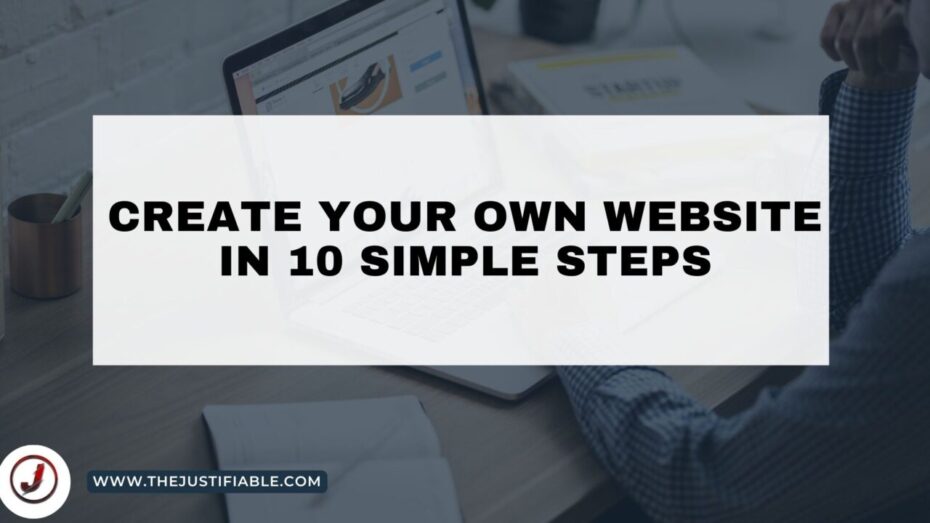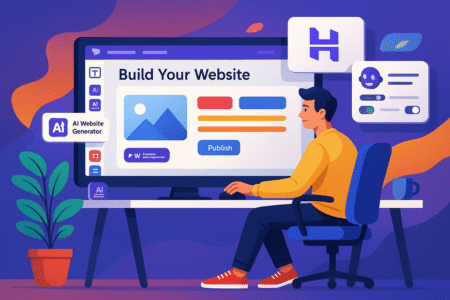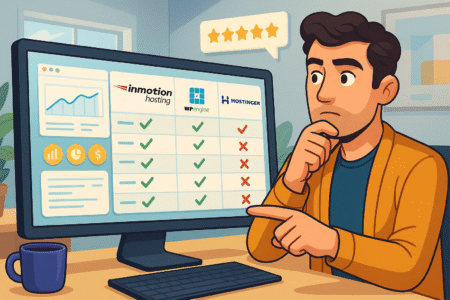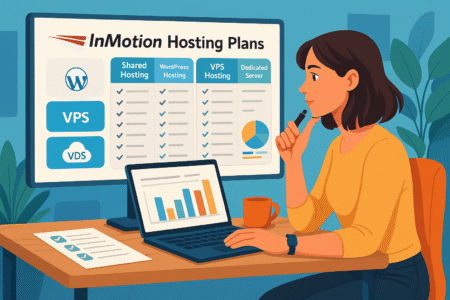Table of Contents
Create your own website – Creating your own website may appear to be a daunting task, but it is a necessary step for anyone seeking to establish a strong online presence.
Having a website can help you reach a larger audience, showcase your work, and establish credibility in your field, whether you’re an entrepreneur, blogger, or creative professional.
In this comprehensive guide, we’ll walk you through the ten simple steps required to build your own website from the ground up.
Step 1: Determine the Purpose of Your Website
It is critical to define the purpose of your website before you begin building it. Consider this: what do I hope to achieve with this website? Are you putting together a portfolio to show off your work? A blog where you can express your ideas and opinions?
A company website to sell goods or services? Knowing the purpose of your website will assist you in creating content that is tailored to your audience and will guide your design decisions.
Step 2: Choose a Platform
After you’ve determined the purpose of your website, it’s time to select a platform. There are numerous website builders and CMS platforms available, each with their own set of advantages and disadvantages.
WordPress, Wix, Squarespace, and Shopify are all popular options. When selecting a platform, consider your technical skills, budget, and the features you require.
Step 3: Select a Theme or Template
After you’ve decided on a platform, you’ll need to choose a theme or template. Most website builders provide pre-designed templates and themes that you can customize to meet your specific requirements.
Look for a layout that matches the purpose and style of your website, and make sure you can easily customize it to make it unique.
Step 4: Plan Your Website’s Structure and Navigation
With your design in place, it’s time to plan the structure and navigation of your website. Create a site map to organize your content and decide on the menu and navigation structure for your website.
Make sure your website is simple to use and navigate.
Step 5: Create Content for Your Website
It’s now time to start creating content for your website. Create compelling copy for your homepage and about page, plan your blog content and categories, and enhance your content with multimedia elements such as images, videos, and infographics.
Step 6: Optimize Your Website for SEO
Search engine optimization (SEO) is critical for ensuring that your website appears high in search engine results pages (SERPs).
Conduct keyword research to find the best search terms for your content, optimize your website’s meta tags, title, and descriptions, and make sure it’s mobile-friendly and fast to load.
Step 7: Set Up Analytics and Tracking
Set up analytics and tracking to measure the success of your website. Install Google Analytics to track your website’s performance, conversion tracking to measure your website’s success, and traffic monitoring to adjust your strategy as needed.
Step 8: Test Your Website’s Functionality
It is critical to test the functionality of your website before launching it. Check your website’s links, forms, and buttons for broken links and 404 errors, and make sure it’s accessible and compatible with various browsers.
Step 9: Launch Your Website
After all of your preparations have been completed, it is time to launch your website. Publish and go live your website, submit your sitemap to Google and other search engines, and promote your website through social media and other marketing channels.
Step 10: Maintain and Update Your Website
Developing a website is not a one-time event. Regular maintenance and updates are required to keep your website relevant and up to date. To keep your website safe, monitor its performance and analytics data, update your content on a regular basis, and perform regular backups and security checks.
Choosing the Right Platform for Your Website
Before diving into the specifics of each platform, it’s important to consider some key factors that will impact your decision. Here are a few things to keep in mind:
Purpose – What is the purpose of your website? Is it a blog, an e-commerce site, or a portfolio? Different platforms are better suited for different types of websites.
Ease of use – How comfortable are you with technology? Are you looking for a platform that is easy to set up and maintain, or are you willing to invest more time in learning a complex system?
Customization – Do you want the ability to customize your website’s design and functionality, or are you happy with a pre-designed template?
Budget – How much are you willing to spend on your website? Some platforms are free, while others require a monthly or yearly fee.
With these factors in mind, let’s explore some of the most popular website platforms.
WordPress
WordPress is one of the most popular website platforms in the world, powering over 40% of all websites. It is an open-source content management system (CMS) that allows users to create websites using pre-designed templates or custom designs.
Pros:
- Easy to use for beginners
- Large community of users and developers for support
- Wide range of customization options
- SEO-friendly
Cons:
- Can be vulnerable to security threats without proper updates and maintenance
- Plugins can slow down website performance
- Requires some technical knowledge for advanced customization
Squarespace
Squarespace is a website builder that allows users to create websites using pre-designed templates. It is known for its user-friendly interface and sleek, modern designs.
Pros:
- Easy to use, even for beginners
- Wide range of professional-looking templates
- Built-in e-commerce functionality
- Includes hosting and security features
Cons:
- Limited customization options compared to other platforms
- More expensive than some other website builders
Wix is another popular website builder that offers a drag-and-drop interface for creating websites. It is known for its ease of use and offers a range of pre-designed templates.
Pros:
- User-friendly interface
- Wide range of templates
- Easy integration with third-party tools and services
- Includes hosting and security features
Cons:
- Limited customization options compared to other platforms
- Some templates can be difficult to navigate for users with disabilities
- Can be slower to load than other platforms
Shopify
Shopify is an e-commerce platform that allows users to create online stores. It offers a range of features for managing products, inventory, and shipping.
Pros:
- User-friendly interface
- Built-in payment processing and shipping options
- Integrates with a wide range of third-party tools and services
- SEO-friendly
Cons:
- More expensive than some other e-commerce platforms
- Limited customization options compared to other platforms
- Transaction fees for using third-party payment processors
Designing Your Websites Layout, Color, and Fonts
When it comes to creating a website, there are several factors that must be considered. The layout, color, and font choices are critical aspects of website design. Let us look at the key elements that can assist you in creating an appealing and effective website.
Layout
Your website’s layout refers to how the various elements are arranged on the page. It is critical to select a visually appealing and user-friendly layout. The “F-pattern” layout, which mimics how people read, is one of the most popular. Important information is placed in the top left corner of the page and then moves down and to the right.
The “Z-pattern” layout is another popular layout that works well for websites with a lot of visual content. This design follows the natural movement of the eyes from left to right and then down the page.
Whatever layout you choose, it is critical to keep it clean and uncluttered. Use as few images, videos, and other elements as possible to avoid distracting from the main content.
Color
Color is an essential component of website design because it can set the tone and mood of your site. The color palette you select should reflect your company’s branding and be visually appealing to your target audience. Colors should be chosen with the emotions they evoke in mind.
Blue, for example, is frequently associated with trust and professionalism, whereas green is often associated with nature and relaxation. Red, on the other hand, is associated with passion and excitement.
To ensure readability, it is also critical to use contrasting colors for text and background. Avoid using too many bright colors or clashing color combinations.
Fonts
The font you choose for your website can have a big impact on how it looks overall. It is critical to select a font that is easy to read and matches the tone of your website. Sans-serif fonts are popular for websites because they are easy to read on screens and have a modern appearance.
Consider font size, spacing, and color when selecting a font. Headings should have larger font sizes, while body text should have smaller font sizes. Make sure there’s enough space between lines and paragraphs for easy reading.
How to Determine the Purpose of Your Website
When building a website, it’s important to define its purpose. This step will help you create an effective SEO strategy and provide a clear direction for your website’s design and content.
Without a clear purpose, your website may lack focus and not attract the right audience.
Step 1: Identify Your Target Audience
Before you can determine your website’s purpose, you need to know who your target audience is. Consider the demographics of your ideal customer, including their age, gender, location, and interests.
This information will help you create content that resonates with your target audience and meets their needs.
Step 2: Analyze Your Competition
Once you’ve identified your target audience, research your competitors’ websites to see what they’re doing well and what could be improved.
Take note of their design, content, and SEO strategies, and use this information to create a website that stands out and offers something unique.
Step 3: Set Your Website Goals
Your website goals should align with your overall business objectives. Are you looking to increase sales, generate leads, or simply provide information to your audience?
Set specific, measurable goals for your website to help you track its success and make improvements over time.
Step 4: Define Your Unique Selling Proposition (USP)
Your website’s unique selling proposition (USP) is what sets it apart from your competitors. It’s the reason why someone should choose your website over another.
Consider what makes your business unique, whether it’s your products, services, or values, and highlight these in your website’s messaging and design.
Step 5: Create a Content Strategy
Finally, create a content strategy that aligns with your website’s purpose, goals, and target audience. Your content should be informative, engaging, and optimized for SEO.
Use keywords and phrases that your target audience is searching for to increase your website’s visibility in search engine results pages (SERPs).
Essential Maintenance Checklist for Your Website
More than just creating and publishing content is required to run a website. It is critical to keep your website up to date, secure, and running smoothly. That is why creating a regular maintenance checklist is critical to keeping your website in good shape.
Update Software and Plugins
Updating your website software and plugins is one of the most important items on your maintenance checklist. Outdated software can expose your website to security threats while also making it slow and unreliable.
Check that the content management system (CMS), plugins, themes, and other software on your website are up to date.
Check Your Website’s Speed
The speed of your website is an important factor in the user experience. A slow website can harm your search engine rankings and discourage visitors from returning.
Use a tool like Google’s PageSpeed Insights to evaluate your website’s loading time and make the necessary changes to improve its speed.
Test Website Responsiveness
A responsive website adjusts to different screen sizes, such as desktops, tablets, and smartphones. Because the majority of internet users access websites via mobile devices, it is critical that your website is responsive.
Test your website’s responsiveness with tools like Google’s Mobile-Friendly Test and address any issues that arise.
Backup Your Website
Backing up your website is an important part of website upkeep. In the event of a hack or an unintentional deletion, you can restore your website from a backup. Make regular backups of your website and keep them in a secure location.
Scan for Malware
Malware can cause damage to your website, steal data, and ruin your reputation. As a result, it’s critical to scan your website for malware on a regular basis. To detect and remove malware from your website, use security plugins or online scanners.
Check Broken Links
Broken links can have an impact on the user experience and search engine rankings of your website. Check for broken links using tools like Google Search Console and fix them as soon as possible.
Check for Accessibility Issues
Making your website accessible to all users, including those with disabilities, is critical. Check your website for accessibility issues and fix them using tools like Wave or Axe.






